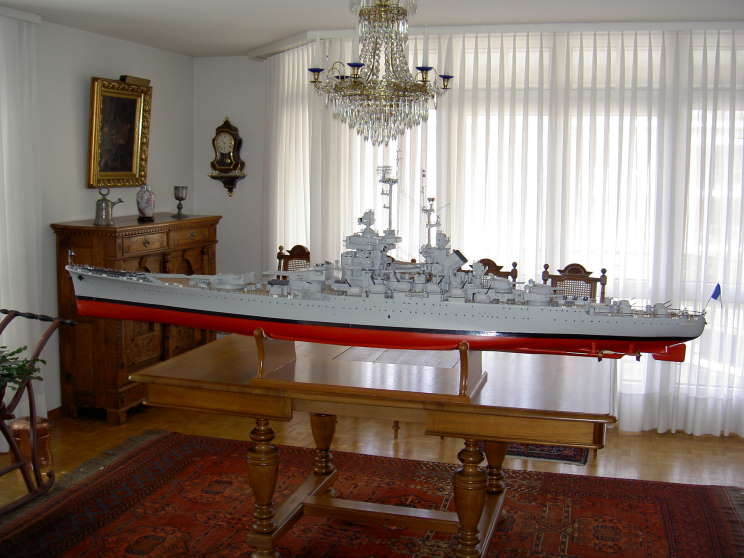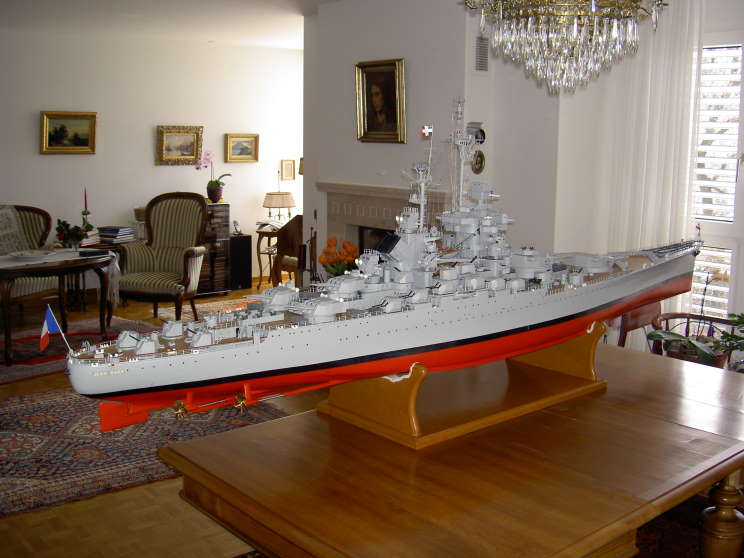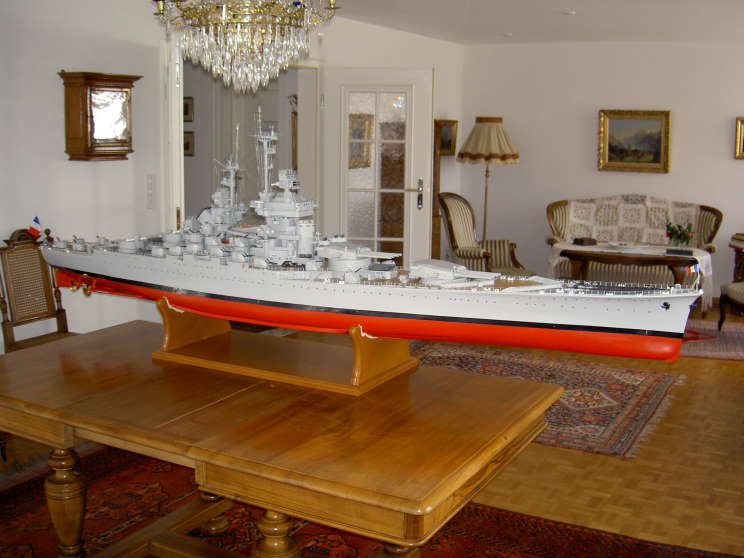Jean Bart |
|
Model by
Alain L. Hanselmann
|
 |
Scratch built model of Jean Bart. |
 |
Scratch built model of Jean Bart. |
 |
To build a 1/100 scale battleship is a large project and the first problem is to find the exact details on a certain period. Naval vessels are often modified during the time they leave the shipyards and until they meet the scrapyards The Jean Bart drawings to be found in the commerce were insufficient. But then the "Centre d'Archives de l'Armement " in Chatellerault /France was able to send a large set of workshops drawings of excellent quality and at a fair price. Still more details had to be found in books on the subject and the postcards editing company "Marius Bar "in Toulon. Last but not least, the Marine Musée in Paris has a special archives on each French ship and copies can be made for the interesting details. My Jean Bart is built as it was in Summer 1953 this is with ten pieces of 20 mm Oerlikon single mounts still on board. The model is 2.48 meters long and weights about 45 kgs. To facilitate transport the hull is in two pieces with two 5mm stainless steel frames bolted in the middle. Both sections are plank on frames construction with a distance of 120 mm between each frame. A large part of the keel is made from a U aluminium profile 20x15 mm. On either side from the steel bulkheads are the first three frames connected with four pieces M3 threaded rods in order to make both half hulls a very strong cage. Once the hull is planked it is coated with polyester gel and fiberglass cloth. The bonding of this make a very strong hull, but the sanding of this large piece is not the nicest part of the construction. Best is to do it outside and with a face mask. The main guns (380 mm) turrets forward were each made separately and the guns made of aluminium were put in place. The secondary artillery consists of three triple turrets (152mm) relatively close to each other. A wood form was made and painted then put in a open box made of thin balsa wood. After a coating of teflon spray a moulding rubber was poured in this box. After one day the wood turret can be removed carefully and the empty form coated with polyester gel. After the drying there are three perfectly similar turrets casings ready to take the brass guns. The same technic was used for the twelves 100mm AA turrets, the five boats, four rangefinders for the 100mm guns and five rangefinders for the 57mm. The forms of the rangefinders made it necessary to split the moulds in two sections. The superstructures are made of plywood and brass sheets. The major problem and this amounts probably to one third of the construction time is to find with an enlarging glass each detail, ribs, windows tubings etc from the post cards and pictures. Very thin parts like radars arrays, ladders protections, cover screens etc. were made by a photo etching company in UK after my drawings. The four beautiful propellers made of brass are from UK too. The four shafts are each propelled with its own gearmotor 12 volts and each side are connected to one speed controller. This allows the large model to turn on the same spot. On water this ship needs a careful hand and thinking well ahead because of its size and weight. As I was working at the time travelling overseas for nearly 50 % of the year it took me 14 years to finish this project. This is about 4,500 hours of work. One last comment, why the Jean Bart? Jean Bart was the last and most modern battleship completed. It was a fitting conclusion to the era started with "Dreadnought" in 1905. Jean Bart never killed anyone... this is a friendly feature. Jean Bart looked rather more attractive than did her sister-ship Richelieu, the main reason for this being the cut down forward superstructure, making the ship appear more compact. Jean Bart's AA armament was the most powerful ever fitted on a capital ship, consisting of 52 barrels of between 57 and 100mm calibre. In theory she was capable of firing 3,832 rounds per minute, and thus throw up a curtain of fire around the ship which would be very difficult to penetrate. |
(All photos and text courtesy of
Alain L. Hanselmann) © Alain L. Hanselmann all rights reserved |
Class Overview |
||
Page published June 12, 2011 |